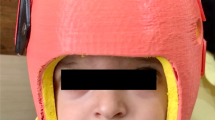Abstract
Aims
Endoscopy-assisted treatment of craniosynostosis constitutes a novel modality for management of complex craniosynostoses. In this work, the authors aimed to assess the safety and advantages of performing these techniques in patients under 4 months of age.
Patients and methods
Our study group comprised patients aged 4 months or younger with multiple-suture craniosynostosis undergoing endoscopy-assisted cranial remodeling.
Results
Between March 2007 and June 2011, we treated seven patients with combined affected sutures, five with unclassified nonsyndromic craniosynostosis, one with Muenke’s and another with Crouzon’s syndromes. One child with a cloverleaf skull had a family history of craniosynostosis. Mean age at diagnosis was 35.3 days (1–90 days). The most frequent combinations of involved sutures were sagittal and bicoronal suture (n = 3) and bilateral coronal suture (n = 3). Mean age at treatment was 62.8 days (13–109 days). Blood transfusion was required in only two patients. The mean length of hospital stay was 2.3 days (2–4 days). Mean follow-up period was 20.14 months (7–46 months). No patient presented ventriculomegaly or Chiari I malformation in follow-up studies, and only one showed a vertical disposition of the posterior fossa. No patient presented complications related to the procedures. A good result (Barlett I) was observed at 3- and 6-month follow-up visits. Four patients followed up for more than 1 year did not develop craniolacunae.
Conclusion
Endoscopy-assisted surgery for correction of craniosynostosis in children under 4 months represents a valid and safe management option. Early treatment may contribute to prevent the development of associated ventriculomegaly and Chiari I malformation.





Similar content being viewed by others
References
Jimenez DF, Barone CM (2007) Early treatment of anterior calvarial craniosynostosis using endoscopic-assisted minimally invasive techniques. Childs Nerv Syst 23:1411–1419
Jimenez DF, Barone CM (2010) Multiple-suture nonsyndromic craniosynostosis: early and effective management using endoscopic techniques. J Neurosurg Pediatr 5:223–231
Johnson JO, Jimenez DF, Barone CM (2007) Blood loss after endoscopic strip craniectomy for craniosynostosis. J Neurosurg Anesthesiol 12:60
Rivero-Garvía M, Márquez-Rivas J, Giménez-Pando J (2011) Craniosynostosis (letter). J Neurosurg Pediatr 7:218–219
Author information
Authors and Affiliations
Corresponding author
Rights and permissions
About this article
Cite this article
Rivero-Garvía, M., Marquez-Rivas, J., Rueda-Torres, A.B. et al. Early endoscopy-assisted treatment of multiple-suture craniosynostosis. Childs Nerv Syst 28, 427–431 (2012). https://doi.org/10.1007/s00381-011-1621-8
Received:
Accepted:
Published:
Issue Date:
DOI: https://doi.org/10.1007/s00381-011-1621-8




